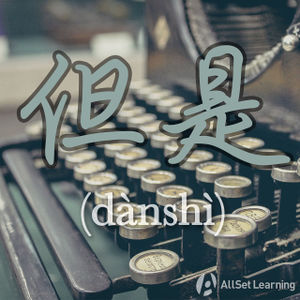Difference between revisions of "Expressing "although" with "suiran" and "danshi""
| Line 1: | Line 1: | ||
{{Grammar Box}} | {{Grammar Box}} | ||
| − | The grammar pattern " | + | The grammar pattern "虽然⋯⋯ 但是⋯⋯" (suīrán... dànshì...) is one of the most common used patterns in Chinese, especially in written Chinese. You can think of it as meaning "[[although]]," but unlike in English, you still need to follow it with a "[[but]]" word in Chinese. |
== Structure == | == Structure == | ||
| − | "虽然 | + | "虽然 ⋯⋯ 但是 ⋯⋯ " expresses that while the former part of the sentence is true, there is an adverse reaction in the latter part. |
<div class="jiegou"> | <div class="jiegou"> | ||
| Line 13: | Line 13: | ||
</div> | </div> | ||
| − | Simply put, the pattern means, ''although | + | Simply put, the pattern means, ''although..., but...'' In English, you wouldn't normally need the "but" there, but it is required in Chinese. Be aware that "可是" can be used interchangeably with "但是" for the "but" part. |
== Examples == | == Examples == | ||
| Line 40: | Line 40: | ||
[[Category:B1 grammar points]] | [[Category:B1 grammar points]] | ||
| − | {{Basic Grammar|虽然|B1| | + | {{Basic Grammar|虽然|B1|虽然⋯⋯ 但是⋯⋯|<em>虽然</em> 渴 了,<em>但是</em> 不 想 喝 啤酒。|grammar point|ASGXI560}} |
{{Rel char|但是}} | {{Rel char|但是}} | ||
{{Rel char|但}} | {{Rel char|但}} | ||
Revision as of 16:12, 20 October 2016
-
Level
-
Similar to
-
Used for
-
Keywords
The grammar pattern "虽然⋯⋯ 但是⋯⋯" (suīrán... dànshì...) is one of the most common used patterns in Chinese, especially in written Chinese. You can think of it as meaning "although," but unlike in English, you still need to follow it with a "but" word in Chinese.
Structure
"虽然 ⋯⋯ 但是 ⋯⋯ " expresses that while the former part of the sentence is true, there is an adverse reaction in the latter part.
虽然 + Subj. + 但是 + Contrary Reaction
Simply put, the pattern means, although..., but... In English, you wouldn't normally need the "but" there, but it is required in Chinese. Be aware that "可是" can be used interchangeably with "但是" for the "but" part.
Examples
- 虽然 他 是 美国 人 ,但是 他 还 没 去 过 华盛顿。 Although he's American, he still hasn't been to Washington D.C.
- 虽然 她 说 不 太 饿,但是 她 点 了 很 多 菜。Even though she said she isn't hungry, she ordered a lot of food.
- 虽然 他 的 家里 很 有钱,可是 他 从来 不浪费 钱。Even though he‘s got a rich family, he never wastes money.
See also
Sources and further reading
Books
- Basic Patterns of Chinese Grammar (pp. 115-6) →buy
- Common Chinese Patterns 330 (汉语常用格式330例) (pp. 217) →buy
- Integrated Chinese: Level 1, Part 1 (3rd ed) (pp. 245) →buy
- Modern Mandarin Chinese Grammar: A Practical Guide (pp. 256-7) →buy
- New Practical Chinese Reader 2 (新实用汉语课本2) (pp. 177) →buy



